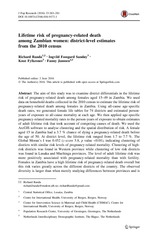| dc.contributor.author | Banda, Richard | en_US |
| dc.contributor.author | Sandøy, Ingvild Fossgard | en_US |
| dc.contributor.author | Fylkesnes, Knut | en_US |
| dc.contributor.author | Janssen, Fanny | en_US |
| dc.date.accessioned | 2016-12-30T07:33:34Z | |
| dc.date.available | 2016-12-30T07:33:34Z | |
| dc.date.issued | 2016-09 | |
| dc.Published | Journal of Population Research 2016, 33(3):263-281 | eng |
| dc.identifier.issn | 1443-2447 | |
| dc.identifier.uri | https://hdl.handle.net/1956/15293 | |
| dc.description.abstract | The aim of this study was to examine district differentials in the lifetime risk of pregnancy-related death among females aged 15–49 in Zambia. We used data on household deaths collected in the 2010 census to estimate the lifetime risk of pregnancy-related death among females in Zambia. Using all-cause age-specific death rates, we generated female life tables for 74 districts and estimated person-years of exposure to all-cause mortality at each age. We then applied age-specific pregnancy-related mortality rates to the person-years of exposure to obtain estimates of adult lifetime risk that took account of competing causes of death. We used the ArcGIS software to analyse clustering and the spatial distribution of risk. A female aged 15 in Zambia had a 3.7 % chance of dying a pregnancy-related death before the age of 50. At district level, the lifetime risk ranged from 1.7 to 7.7 %. The Global Moran’s I was 0.452 (z-score 5.8, p value <0.01), indicating clustering of districts with similar risk levels of pregnancy-related mortality. Clustering of high-risk districts was found in Western province while clustering of low risk districts was found in Lusaka and Muchinga provinces. The level of adult lifetime risk was more positively associated with pregnancy-related mortality than with fertility. Females in Zambia have a high lifetime risk of pregnancy-related death overall but this risk varies greatly across the different districts of the country. The observed diversity is larger than when merely studying differences between provinces and is only weakly linked to differences in fertility levels. The identification of districts with varying levels of risk should enable evidence-based and focused delivery of maternal health services in districts where risk of death from maternal causes is greatest. | en_US |
| dc.language.iso | eng | eng |
| dc.publisher | Springer | eng |
| dc.rights | Attribution CC BY | eng |
| dc.rights.uri | http://creativecommons.org/licenses/by/4.0 | eng |
| dc.subject | Pregnancy-related death | eng |
| dc.subject | Lifetime risk | eng |
| dc.subject | Census | eng |
| dc.subject | Zambia | eng |
| dc.subject | Maternal mortality | eng |
| dc.title | Lifetime risk of pregnancy-related death among Zambian women: district-level estimates from the 2010 census | en_US |
| dc.type | Peer reviewed | |
| dc.type | Journal article | |
| dc.date.updated | 2016-12-15T15:18:06Z | |
| dc.description.version | publishedVersion | en_US |
| dc.rights.holder | Copyright 2016 The Author(s) | |
| dc.identifier.doi | https://doi.org/10.1007/s12546-016-9172-1 | |
| dc.identifier.cristin | 1407873 | |

